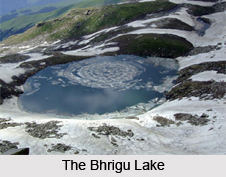 Bhrigu Lake is located near Manali in Kullu district of Himachal Pradesh. More specifically, it is located to the east of Rohtang Pass. The lake is around 6 kilometres from Gulaba. It is named after Maharishi Bhrigu. Characteristically, this lake is an alpine lake with serene atmosphere around and is also held sacred for its mythical significance. The shallow lake remains frozen for more than half of the year. This lake is one of the prominent tourist attractions of Himachal Pradesh.
Bhrigu Lake is located near Manali in Kullu district of Himachal Pradesh. More specifically, it is located to the east of Rohtang Pass. The lake is around 6 kilometres from Gulaba. It is named after Maharishi Bhrigu. Characteristically, this lake is an alpine lake with serene atmosphere around and is also held sacred for its mythical significance. The shallow lake remains frozen for more than half of the year. This lake is one of the prominent tourist attractions of Himachal Pradesh.
History of Bhrigu Lake
History highlights that a sage called Bhrigu of Saptarishi fame used to meditate near this lake. Also, many local Gods of kullu region took a dip in the waters of this lake. For example, guru Vashisht visited this lake at least once in two or three years. Hence, this lake is considered sacred. It is for this reason that the locals believe that this lake never freezes completely.
Geography of Bhrigu Lake
The Bhrigu Lake is located at an elevation of about 4235 metres above mean sea level. Therefore, this lake is at high altitude.
Tourist Attractions of Bhrigu Lake
The Bhrigu Lake serves as a tourism product for Himachal Pradesh, basically in terms of trekking. Several trekking routes lie adjacent to the Bhrigu Lake. The Bhrigu Lake trek route is easily accessible in the upper Kullu valley. Carrying the appropriate trekking equipment, one can experience the virgin forests and lush green meadows on the way. Trekkers can have a bird"s eye view of the surrounding valleys like upper Kullu, Solang and Rohtang. They can also experience the snow clad peaks and ranges of Dhauladhar, Pir Panjal, Great Himalaya and numbers of peak rising above 6000m. Campsite near the lake is also a fun-filled possibility. Nehru Kund, a natural spring of cold water rising from this lake, serves as an attraction of this lake. Apart from the spring, a neatly carved wooden temple, surrounding waterfalls, village home-stays, availability of world cuisines make it a compelling destination for tourists and hikers. The shores of the lake are sparsely populated, which may be an advantage for tourists.
Related Articles:
Lakes of India
Renuka Lake
Dal Lake
Prashar Lake
Rewalsar Lake
Khajjiar Lake
Nako Lake
Gobind Sagar



















